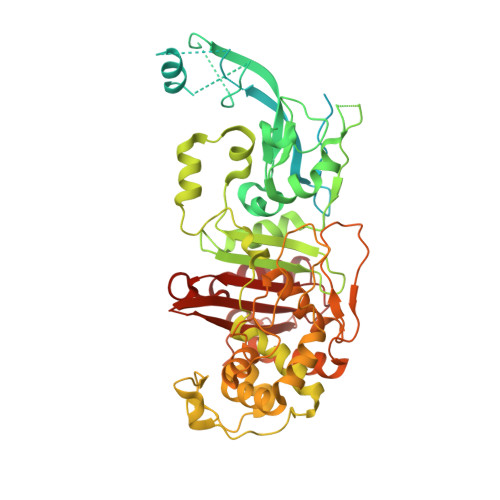The structures of penicillin-binding protein 4 (PBP4) and PBP5 fromEnterococciprovide structural insights into beta-lactam resistance.
Moon, T.M., D'Andrea, E.D., Lee, C.W., Soares, A., Jakoncic, J., Desbonnet, C., Garcia-Solache, M., Rice, L.B., Page, R., Peti, W.(2018) J Biol Chem 293: 18574-18584
- PubMed: 30355734
- DOI: https://doi.org/10.1074/jbc.RA118.006052
- Primary Citation of Related Structures:
6BSQ, 6BSR, 6MKA, 6MKF, 6MKG, 6MKH, 6MKI, 6MKJ - PubMed Abstract:
The final steps of cell-wall biosynthesis in bacteria are carried out by penicillin-binding proteins (PBPs), whose transpeptidase domains form the cross-links in peptidoglycan chains that define the bacterial cell wall. These enzymes are the targets of β-lactam antibiotics, as their inhibition reduces the structural integrity of the cell wall. Bacterial resistance to antibiotics is a rapidly growing concern; however, the structural underpinnings of PBP-derived antibiotic resistance are poorly understood. PBP4 and PBP5 are low-affinity, class B transpeptidases that confer antibiotic resistance to Enterococcus faecalis and Enterococcus faecium , respectively. Here, we report the crystal structures of PBP4 (1.8 Å) and PBP5 (2.7 Å) in their apo and acyl-enzyme complexes with the β-lactams benzylpenicillin, imipenem, and ceftaroline. We found that, although these three β-lactams adopt geometries similar to those observed in other class B PBP structures, there are small, but significant, differences that likely decrease antibiotic efficacy. Further, we also discovered that the N-terminal domain extensions in this class of PBPs undergo large rigid-body rotations without impacting the structure of the catalytic transpeptidase domain. Together, our findings are defining the subtle functional and structural differences in the Enterococcus PBPs that allow them to support transpeptidase activity while also conferring bacterial resistance to antibiotics that function as substrate mimics.
Organizational Affiliation:
From the Department of Chemistry and Biochemistry, College of Medicine, University of Arizona, Tucson, Arizona 85721.
















